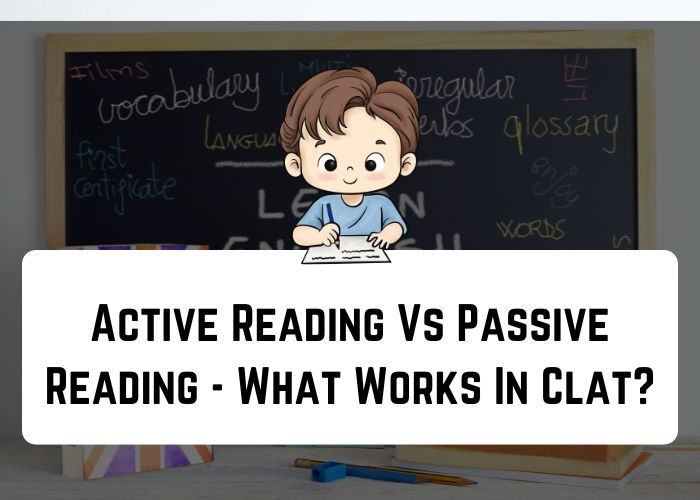Active Reading vs Passive Reading: What Works in CLAT?
- himanshilawprep
- Jul 18
- 6 min read

As you're preparing for the CLAT exam, you must have heard it many times: “Start reading regularly.” But the real question is-how should you read? Because in CLAT, simply reading more won’t help unless you read the right way.
That’s where active reading vs passive reading comes into the picture. These two reading styles are completely different, and only one of them will truly help you score better in CLAT.
Let’s understand what each one means, how they affect your preparation, and why shifting to active reading could be one of the smartest moves in your CLAT journey.
1. What is Passive Reading?
Passive reading is what most students unknowingly do. In this style, you read something, your eyes are moving, but your brain is not fully involved. It’s like your body is attending class, but your mind is thinking about your phone’s notifications.
Examples of passive reading:
Reading just to finish the article or passage
Reading without trying to understand the core idea
Getting distracted while reading and not realizing it
Reading an editorial, but forgetting everything five minutes later
If you’ve ever read a full paragraph and then asked yourself, “What did I just read?”-you’ve experienced passive reading.
Passive reading gives you the illusion of effort, but it doesn’t improve your CLAT skills. You’re reading, but not learning. To stay clear on the concepts of how to prepare for CLAT, you need more than just reading-you need to read with intention, engagement, and understanding.
2. Why Passive Reading is Not Enough for CLAT
The CLAT exam is heavily passage-based now. It doesn’t test memory-it tests understanding, logic, and application. Every section has lengthy passages followed by 4–5 comprehension-based questions.
Here’s what happens when you rely on passive reading:
You don’t fully understand the passage
You keep rereading parts again and again
You waste time trying to “figure it out”
You miss the author’s tone, logic, or deeper meaning
You get confused between similar-looking options
And when the pressure of a timed exam kicks in, passive reading becomes even more risky. If you’re not fully present while reading, the passage will feel longer, the questions harder, and the time shorter.
3. What is Active Reading?
Now let’s talk about what actually works-active reading. This is a smarter and more involved way of reading. Your brain is alert, engaged, and working with the content—not just watching words fly by.
In active reading, you:
Ask yourself questions as you read
Understand the author’s main point and tone
Try to predict what might come next
Spot arguments, assumptions, and conclusions
Summarize the idea in your own words
Think: “What is the message behind this sentence?”
In simple words, active reading means you’re not just reading-you’re thinking along with the writer.
This is the exact reading skill CLAT expects. And this is what helps you read faster, understand better, and solve questions accurately.
4. How CLAT is Designed for Active Readers
Almost every part of the CLAT paper is based on reading and understanding. Whether it’s legal, logical, or English-based, all sections reward students who can think while they read.
Let’s look at how active reading helps in each section:
English Language: You’ll face editorials and opinion-based passages. Active reading helps you understand the writer’s tone, message, and the hidden meaning in tricky sentences. This is how you confidently answer inference and vocabulary-based questions.
Logical Reasoning: Here, you’ll read arguments and identify conclusions, assumptions, or weaknesses. Active readers easily break the paragraph into parts and understand the flow of logic. Passive readers often get stuck because they didn’t fully understand the argument.
Legal Reasoning: Even if you haven’t studied law, the exam gives you the principle in the passage itself. Active reading helps you grasp it quickly and apply it to the given situation. Passive reading will make you memorize terms instead of applying logic.
Current Affairs & GK: CLAT doesn’t ask basic one-liners anymore. Instead, it gives passages about ongoing issues or events. If you actively read the news and understand the story behind headlines, you’ll easily connect facts and answer related questions in the exam.
5. Why Many Students Think They're Reading Actively (But They're Not)
This is where many students go wrong. They say, “I read the newspaper daily,” or “I do passages regularly.” But in reality, they are often reading without focus or without asking any questions while reading.
Here’s how to know if you’re not reading actively:
You keep highlighting things without knowing what’s really important
You have to read the same line 3-4 times to understand it
You reach the end of a passage but don’t remember anything
You struggle to explain what you read in your own words
The problem is not your vocabulary or your background. It’s just that you haven’t developed the habit of involved reading yet. The good part? It can be learned, and the earlier you build this habit, the better your chances of improving for CLAT 2026.
6. How to Build Active Reading Skills (Step-by-Step)
You don’t need to be a topper to start reading actively. You just need to make small changes in the way you approach your reading material every day.
Here’s how to get started:
Step 1: Read with a Purpose: Before starting any passage or article, ask yourself:“What am I looking for?” Maybe it’s the main argument. Maybe it’s the tone. Maybe you just want to understand the opinion. Having a goal in mind helps you stay focused and think while reading.
Step 2: Pause and Reflect: After every paragraph or key sentence, take a second to ask: What did the writer just say? Why is this point important? How does this connect to the previous part? This reflection is where the real learning happens.
Step 3: Don’t Highlight Everything: Many students think highlighting means they’re studying. But if you highlight every sentence, you’re not selecting the important parts. Highlight or underline only after you’ve understood the idea. Not before.
Step 4: Practice Explaining: Once you’ve finished a passage, try to explain it in 2-3 sentences-either to yourself, to a friend, or even out loud.If you can explain it clearly, that means you’ve read it actively. If not, revisit the parts you missed.
7. What If English is Not Your First Language?
This is a common concern among CLAT aspirants. But here’s the truth: you don’t need perfect English to become an active reader.
You just need consistent practice with the right method.
Here’s what you can do:
Start with slightly easier articles or stories
Read them slowly, and try to understand the meaning without translating word-by-word into Hindi
If you find a difficult word, don’t panic-use the sentence to guess the meaning
Maintain a small notebook to write down new words and their usage in simple sentences
Watch English news clips with subtitles and follow along
Over time, your reading speed and understanding will improve naturally.
And remember, many CLAT toppers have come from Hindi-medium and regional-language backgrounds. What made the difference was not their grammar-it was their method of reading.
8. Example: Active vs Passive Reading in Real Life
Let’s take a simple paragraph: “Although social media has allowed people to stay connected during times of isolation, it has also contributed to increased anxiety and poor sleep habits among teenagers.”
A passive reader might:
Read it quickly and move on
Not notice the contrast being made
Forget the idea within minutes
An active reader would:
Notice that the sentence is showing both benefits and problems of social media
Understand that the tone is balanced but slightly critical
Predict that the author may talk about mental health issues further
Be able to explain: “The author is saying social media helps us connect, but also harms our mental health.”
This difference in approach is what improves your CLAT answers and saves time during the paper.
9. Build This as a Daily Habit
Reading actively should not be a once-in-a-while thing. It should become your daily habit. Every day, choose one article or passage and practice reading it with full focus. Even 30 minutes of quality reading daily can improve your comprehension drastically over time.
You can use editorials from The Hindu, Indian Express, or legal news sites. The idea is not to read more, but to read better. Don’t rush. Focus on understanding.
The better your reading skills become, the faster you’ll solve questions in the actual exam. And you’ll feel more confident while doing it.
Also checkout Mock Test strategy for CLAT
10. Final Words - Read Less, Understand More
In CLAT, time is limited and competition is high. You don’t get extra marks for reading fast or finishing early. You get marks only when you understand and answer correctly.
So instead of worrying about how many passages you’ve read today, focus on how deeply you understood what you read.
Active reading is not just a CLAT technique-it’s a success strategy. It helps you stay focused, calm, and clear-headed during the exam. And it prepares you for law school as well, where you’ll have to read complex judgments, legal arguments, and more.
So, the next time you sit with a newspaper or a mock passage-don’t just read. Think. Connect. Question. Understand.
That’s what active readers do. And that’s what CLAT rewards.






Comments